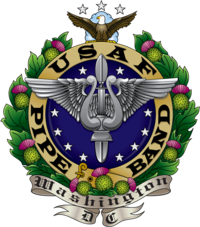
Tyndall Air Force Base is a United States Air Force Base located 12 miles (19 km) east of Panama City, Florida. The base was named in honor of World War I pilot 1st Lt. Frank Benjamin Tyndall. The base operating unit and host wing is the 325th Fighter Wing of the Air Combat Command (ACC). The base hosts 2,902 active duty members. In October 2018, Hurricane Michael caused significant damage to the base.
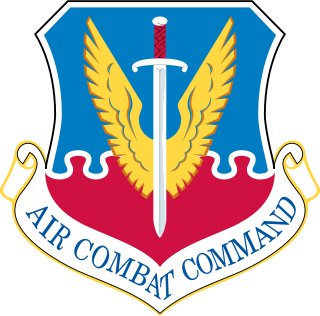
The Air Combat Command (ACC) is one of nine Major Commands (MAJCOMs) in the United States Air Force, reporting to Headquarters, United States Air Force (HAF) at the Pentagon. It is the primary provider of air combat forces for the Air Force, and it is the direct successor to Tactical Air Command. Air Combat Command is headquartered at Langley Air Force Base, Joint Base Langley–Eustis, Virginia, United States.

Andrews Air Force Base is the airfield portion of Joint Base Andrews, which is under the jurisdiction of the United States Air Force. In 2009, Andrews Air Force Base merged with Naval Air Facility Washington to form Joint Base Andrews. Andrews, located near Morningside, Maryland in suburban Washington, D.C., is the home base of two Boeing VC-25A aircraft with the call sign Air Force One when the president is on board, that serve the President of the United States, and the President is typically flown in and out of Andrews when travelling from Washington, D.C. by plane.

The Air Mobility Command (AMC) is a Major Command (MAJCOM) of the U.S. Air Force. It is headquartered at Scott Air Force Base, Illinois, east of St. Louis, Missouri.
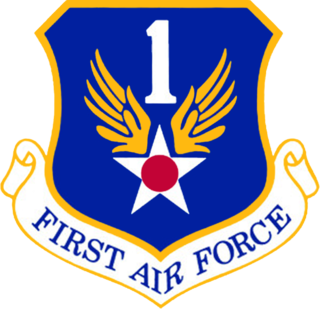
The First Air Force is a numbered air force of the United States Air Force Air Combat Command (ACC). It is headquartered at Tyndall Air Force Base, Florida. Its primary mission is the air defense of the Contiguous United States (CONUS), United States Virgin Islands and Puerto Rico. Since May 2022, it also provides the Air Force contribution to United States Space Command, as Air Forces Space (AFSPACE), including support functions for NASA human space flight.
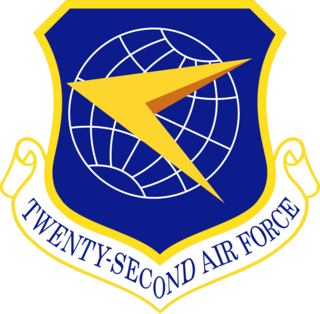
Twenty-Second Air Force is a Numbered Air Force component of Air Force Reserve Command (AFRC). It was activated on 1 July 1993 and is headquartered at Dobbins Air Reserve Base, Georgia.

The Texas Air National Guard (TX ANG) is the aerial militia of the State of Texas, United States of America. It is, along with the Texas Army National Guard, an element of the Texas National Guard. No element of the Texas Air National Guard is under United States Air Force command. They are under the jurisdiction of the Governor of Texas through the office of the Texas Adjutant General unless they are federalized by order of the President of the United States. The Texas Air National Guard is headquartered at Camp Mabry, Austin, and its chief of staff is Brigadier General Matthew Barker.

United States military bands include musical ensembles maintained by the United States Army, United States Marine Corps, United States Navy, United States Air Force, and United States Coast Guard. More broadly, they can also include musical ensembles of other federal and state uniformed services, including the Public Health Service and NOAA Corps, the state defense forces, and the senior military colleges.

The Air Force District of Washington (AFDW) is a Direct Reporting Unit of the United States Air Force. AFDW oversees Air Force operations in the Washington, D.C. region.
The structure of the United States Air Force refers to the unit designators and organizational hierarchy of the United States Air Force, which starts at the most senior commands.

The uniforms of the United States Air Force are the standardized military uniforms worn by airmen of the United States Air Force to distinguish themselves from the other services.

The North Carolina Air National Guard (NCANG) is the aerial militia of the State of North Carolina, United States of America. It is, along with the North Carolina Army National Guard, an element of the North Carolina National Guard.

Twenty-Fourth Air Force / Air Forces Cyber (AFCYBER) was a Numbered Air Force within the United States Air Force. The Air Force consolidated its cyberspace combat and support forces into 24 AF. 24 AF was the Air Force component of U.S. Cyber Command.

The Regimental Pipes and Drums of The Calgary Highlanders is an authorized volunteer pipe band associated with The Calgary Highlanders of the Canadian Forces. For many years, the band was a bona fide, and separate, military unit unto itself, with a separate Unit Identification Code within the CF. Today, the band has been reduced to volunteer status but officially maintains an establishment of eight paid military musicians on its rolls. The band has had mixed success in competitions, but under the direction of Pipe Major Michael Giles had become successful in the Grade Three circuit in Alberta in the years leading up to the regimental centennial in 2010. The band published a recording to commemorate the 80th anniversary of the Regiment in 1990, titled Eighty Years of Glory and commemorated its centennial in 2010 by releasing a second CD entitled Onward.

The Air Force Global Strike Command (AFGSC) is a Major Command (MAJCOM) of the United States Air Force, headquartered at Barksdale Air Force Base, Louisiana. AFGSC provides combat-ready forces to conduct strategic nuclear deterrence and global strike operations in support of combatant commanders. Air Force Global Strike Command is the Air Force's service component to the United States Strategic Command (USSTRATCOM).

The Royal Military College of Canada Bands is the official group of bands of the Royal Military College of Canada. The group is composed of four sections: the brass and reed, the pipes and drums, highland dancers, and choristers. Total band membership consists of 105 Officer Cadets from the college. Officer Cadets in the band practice three days a week in the morning on top of attending their individual full-time university programs.

Canadian military bands are a group of personnel in the Canadian Armed Forces (CAF) that performs musical duties for military functions. Military bands form a part of the Music Branch of the CAF, composed of six full-time professional Regular Force bands, 15 Regular Force voluntary bands, and 53 part-time reserve force bands. Bands of the Music Branch are often badged with the unit or Canadian Forces base insignia that they support.

There are currently 9 main military bands currently belonging to the South African National Defence Force (SANDF), which represent the different branches of the SANDF and providing music on ceremonial occasions. Since military bands were introduced in the country, they have played a prominent role in public and military life. Pipe bands also play an important role in South African military music, with notable pipe bands coming from the Cape Town Highlanders, Transvaal Scottish Regiment and the South African Military Health Service. Military bands of the SANDF are also affiliated with the police bands of the South African Police Service. In addition to military music, military bands in the SANDF perform different genres, including classical, jazz, pop and light music.
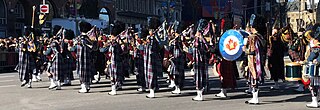
The Royal Canadian Air Force Pipes and Drums (RCAFPD) is a military pipe band unit composed of current members of the Royal Canadian Air Force. The unit was formally established in October 1949 and is the longest continuous serving Air Force Pipe Band in the Canadian Forces. All of its 40 members are volunteers who are drawn from both the military and civilian sphere. At the time of its foundation, it was known as the RCAF Station Rockcliffe Pipe Band.

